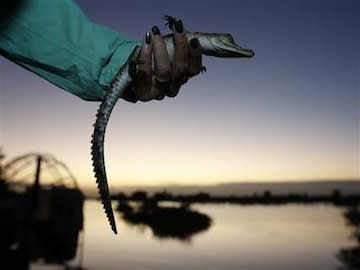 The Sideshow
The SideshowEndangered crocodile finds new life at nuclear power plant

It sounds like the plot for a Syfy movie of the week, but the moral of the story is more heartwarming than terrifying: There's an unexpected newfound harmony between a nuclear power plant and a 15-foot-long endangered species of crocodile.
The Turkey Point Nuclear Power Plant in southeastern Florida has been so good to the American crocodile that the reptile was recently taken off the endangered species list. But the croc's newly thriving condition has nothing to do with nuclear power itself; rather the species has cottoned to the 168 miles of manmade cooling canals that surround the plant, adopting the system as a new natural breeding ground.
"The way the cooling canal system was designed actually turned out to be pretty good for crocodile nesting," said John Wrublik, a biologist with the U.S. Fish and Wildlife Service. "It wasn't designed for crocodiles, but they've done a very good job of maintaining that area."
The recirculating water system at Turkey Point works by pumping water from the canals through a condenser, somewhat like a car's cooling system. The canals and berms used in the process have unintentionally become a nesting habitat for the crocodiles, that has helped lower their risk status from "endangered" to "threatened."
Federal wildlife officials say the crocodiles have experienced a five-fold population increase since the late 70's. And the crocs living in the canals are doing even better than their counterparts at the state's other two official sanctuaries, which still classify the enormous reptile as threatened. In 1997, the American crocodile population was down to just 300, while today, it's estimated to be more than 1,500 and growing.
"We wouldn't advise people to normally make those types of impacts," Wrublik said of removing wetlands to make way for a nuclear power plant. "But this just so happens to have benefited the crocodile population."
What's more, it's not just the crocodiles that are thriving in the power plant canals; dozens of other protected species are booming there as well, including the manatee and loggerhead turtle.
Aside from the canals themselves, the plant's remote location has given the creatures a safety zone rarely found in the state after years of development destroyed most of their natural habitats. And even though humans regard the crocodiles are fierce creatures, they're actually very gentle and intelligent, according to researcher Mario Aldecoa.
"They are very misunderstood. All reptiles are," Aldecoa said. "They are a lot smarter than people think. And they just look like dinosaurs, and that's pretty neat."
Other popular Yahoo! News stories:
• Being left-handed brings mental health risks and reward
• Video: kittens watching ice-skating
• Drunk driver crashes into "Use It and Lose It" DUI command center

